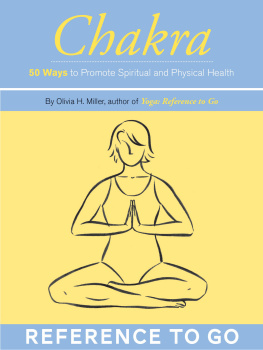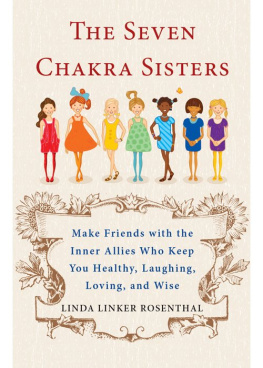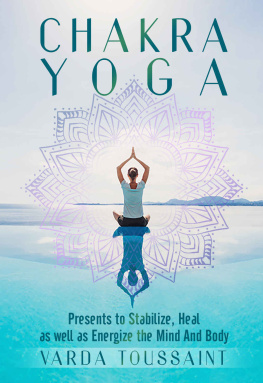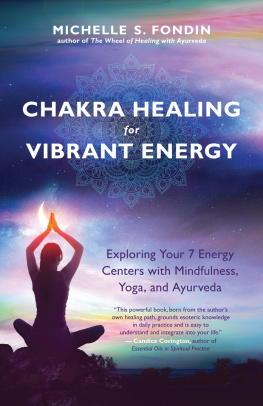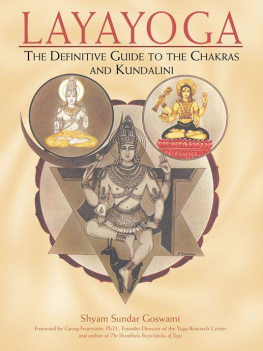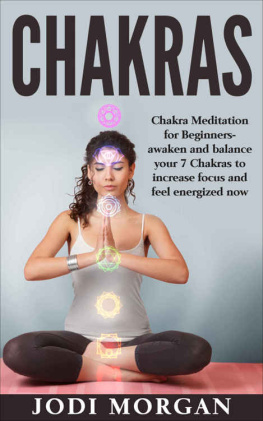CHAKRA: REFERENCE TO GO
50 WAYS TO PROMOTE SPIRITUAL AND PHYSICAL HEALTH
by Olivia H. Miller
Yoga consultant: Michele Damelio
Within the body lie seven vital energy centers. We cant see or feel them; they wont show up in an X ray or MRI. Yet for thousands of years, Eastern cultures have recognized their importance to our physical, emotional, mental, and spiritual health. Through these centers, known as chakras, life energy flows and is processed.
In Sanskrit, an ancient Indian language, chakra means wheel or circle. Balanced chakras can be visualized as spinning vortices, revolving in a clockwise direction at particular frequencies. When imbalanced, chakras may spin counterclockwise and/or the energy may move horizontally or vertically. The first chakra, the Root Chakra, spins at the slowest rate of speed; the seventh, the Crown Chakra, revolves at the highest. Each chakra is also associated with and stimulated by a specific color, and by sounds that vibrate at a similar frequency.
Arranged vertically from the base of the spine to the top of the head, the chakras are part of an energy pathway known as the sushmana, Sanskrit for spine. Energy moves through the central nervous system along the sushmana from the base of the spine through the brain, ending at the tip of the nose. How energy flows in and out of the chakras and up and down this pathway greatly affects us. Balanced chakras allow energy to flow freely, promoting health, vitality, and harmony. Life experiences such as illness, trauma, and stress can cause imbalances, and chakras may become blocked (deficient) or overloaded (excessive).
Imbalances produce a wide array of ailments and disturbances. Often imbalances are temporary, but they can persist, resulting in chronic illness, disease, and habitual patterns of thinking, feeling, and behaving. Fortunately, chakras can be cleared, rebalanced, and energized through yoga, controlled deep breathing (pranayama), and meditation, as well as with gemstones and crystals, flower essences, and essential oils.
Unlike psychotherapy, which focuses on identifying the root of a specific problem in order to solve it, it is not necessary to know which chakras are unbalanced, whether they are deficient or excessive, or what is causing the imbalances in order to balance them again. When the chakras begin to clear, however, you may notice that your habitual thought patterns change, your feelings shift, and new actions or reactions occur. For instance, you may experience more energy, feel more compassionate, or perceive things more clearly. A journey of profound healing and transformation begins.
Although there are many chakras in and around our bodies, Chakra: Reference to Go focuses on the seven major ones. Beginning at the base of the spine and working up, they are: Root, Sacral, Navel Solar Plexus, Heart, Throat, Third Eye, and Crown.
The first three chakras, the lower triangle, may be thought of as our foundation. Grounded in the physical realm, they cover basic life necessities: security, survival, sexuality, intimacy, identity, and ego. The fourth chakra, the Heart Chakra, deals with love and compassion and is considered the bridge to the upper chakras, the higher triangle. These are associated with the spiritual realm: expression, core truth, wisdom, connection to the higher self, and transcendence.
Chakra: Reference to Go features 49 sections, seven for each chakra. A fiftieth section describes the aura, an electromagnetic field that is affected by the movement of energy throughout the chakras.
The seven sections for each chakra include:
A description, which lists basic information: English and Sanskrit names, and key influences such as color, element, gemstones and crystals, flower essences, essential oils, foods, physical location, and associated body parts.
An explanation, which lists ways to identify imbalances; includes a bulleted list of associated physical, emotional, and behavioral issues; summarizes what may be experienced when a chakra is balanced; and suggests activities beneficial to achieving balance.
A breathing exercise and three yoga poses, designed to move stagnant or constricted energy, balance the glandular system, strengthen the respiratory and central nervous systems, and relieve stress. Each section features an illustration of the pose, easy-to-follow instructions, a bulleted list of benefits, and a suggested affirmation targeting the energy of the particular chakra.
A meditation card, which fully integrates the chakras energy throughout the entire being.
How to Use Chakra: Reference to Go
You may wish to start with the Root Chakra, moving sequentially through the book; or, you could focus on a specific chakra, using only those sections. You might select just yoga poses, or only breathing exercises or meditations. Finally, you may want to select sections randomly, allowing inner guidance to choose what is needed.
You may wish to keep a gemstone or crystal nearby or hold it during pranayama or meditation. Essential oils may be used in a diffuser. Flower essences are used typically as a tincture, with drops placed in a glass of water or juice. And you may choose to add suggested foods to your diet.
We offer this book as a transformational tool to stimulate and enhance your physical, emotional, mental, and spiritual health as you awaken and connect to cosmic energy.
Note: Much information about chakras is available in books, on Web sites, and through classes. Chakra: Reference to Go is designed as a handy reference that we hope will entice further exploration and discovery.
Cautions
If you havent exercised before, are pregnant or elderly, have a chronic condition, or have back or neck problems, please consult a medical practitioner before you begin. Not all exercises are suitable for everyone. Do not do any pose that causes undue pain, shortness of breath, or dizziness. Your physical condition and health are important factors in determining which advice and yoga exercises or positions are appropriate for you. This or any other exercise program may result in injury.
Before using any essential oils or flower essences, always read the warning labels or consult a medical practitioner, especially if you are pregnant or suffering from a medical condition.
The author, yoga consultant, illustrator, and publisher of this book disclaim all liability from any injury that may result from the use, proper or improper, of any exercise or advice contained in this book. This book is not intended as a substitute for medical advice or treatment. Please consult your professional health care provider for information and advice on the suitability of your exercise program.
Olivia H. Miller is a freelance writer and has been a student of yoga for more than 25 years. She is the author of Essential Yoga and the Yoga, Stretch, Prenatal Yoga, Yoga II, and Feng Shui Reference to Go titles, all published by Chronicle Books.
Michele Damelio, a certified Kundalini yoga teacher, has taught Kundalini yoga for seven years. A teacher by profession, she has a B.S. in education. She lives and teaches on Cape Cod, Massachusetts.
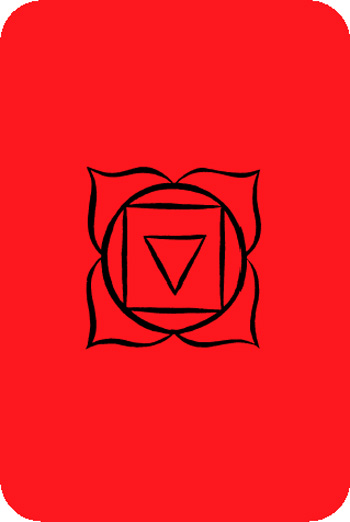
ROOT CHAKRA | DESCRIPTION
1 Root Chakra
Muladhara (home of the root) Safety
Every blade of grass has its angel who bends over it and whispers, Grow, grow.

